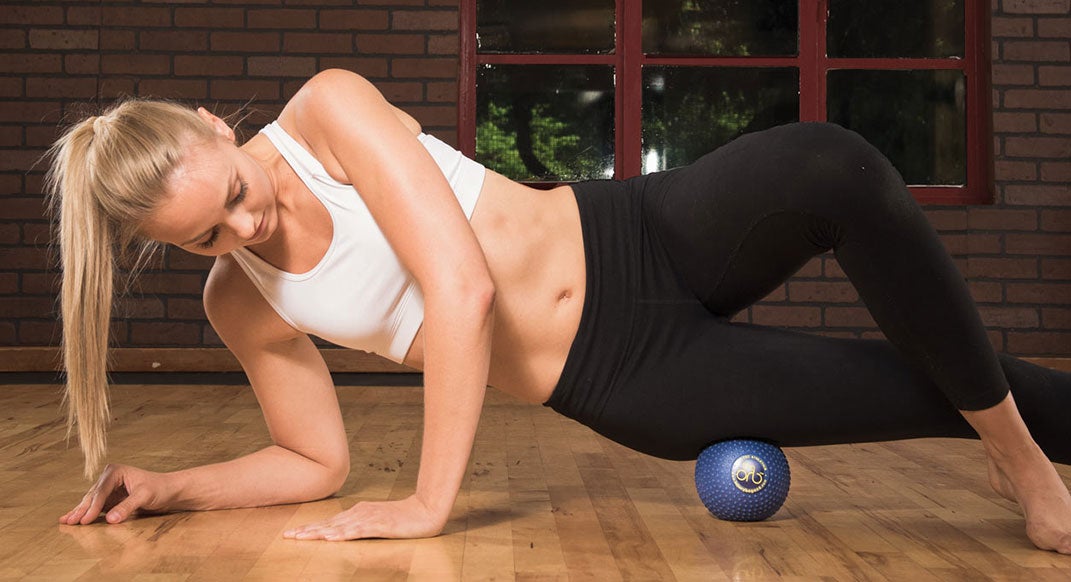Fix Yourself (Without Doing More Damage)

I’m a runner, which means I’m overzealous.
Because I’m overzealous with my running, sometimes I come down with pretty common injuries—shin splints, a sore plantar fascia, tight IT bands, a niggle in the Achilles.
When I can’t run, my overzealousness is channeled into rehab. I could easily spend an hour on the foam roller, rolling a lacrosse ball under my foot, or working my calves with The Stick while catching up on Netflix’s latest binge fodder.
Using these self-massage tools can help assuage sore spots, loosening tight muscles or fascia, an elastic connective tissue that wraps your muscles (examples include the iliotibial band on the outer leg and the plantar fascia on the bottom of the foot).
Depending on an injury’s severity and how acute or generalized the pain is, different implements can stimulate myofascial release by hitting different pressure points. This can help relax contracted muscles and improve blood and lymphatic circulation in sore and immobilized spots, speeding tissue repair.
In other words, armed with a foam roller, lacrosse ball and/or stick, you have a host of tools that can help stave off bigger injuries from the comfort of home.
RELATED: Self Massage To Run And Feel Better
It turns out, though, that my overzealousness can be just as much of a vice when it comes to recovery. That’s right—it’s possible (easy, in fact) to overdo it with do-it-yourself massage and recovery techniques, and exacerbate your injuries with the very tools meant to help them heal. At the very least, use them wrong and you might not be helping yourself much, wasting your time in the process.
For starters—as with running itself—more is not necessarily better when it comes to self-treatment. “The biggest misuse I see when people self-treat is not with the instrument itself but in the amount of time spent on treatment,” says Sam Lezon, a chiropractor and certified strength-and-conditioning specialist based in Minneapolis.
He says that while larger implements like foam rollers spread impact over a larger section of soft tissue, more specific tools such as the Orb, or a lacrosse or golf ball, dig a lot deeper for a particularly acute form of myofascial release called trigger-point therapy.
“If you spend too much time treating a sore and damaged area [with a smaller implements], you can actually increase the amount of inflammation in the tissue, making it temporarily worse,” he says. “Repeat this process daily and you’re in for a tough recovery.”
Here’s more from Lezon on the most common misuses he sees with self-recovery tools, and how to use different tools to maximize recovery while lowering your risk of aggravating an injury.
Lacrosse and Golf Balls
First, to reiterate, Lezon says he sees overuse with small, specific tools as a primary risk for slowing recovery. “A rule of thumb that I suggest athletes use is two minutes, every two days” with smaller implements, he says. “Two minutes of deep tissue work per tender area, every two days. It’s the best way to promote effective healing, without causing too much damage.”
Lezon also says the type of work you do with the ball is important. He sees too many people try to use it as a stationary trigger-point mechanism, rather than moving it around the injured spot.
“That is, an athlete will find a tender spot, place the ball directly on it, and then just lay on it,” he explains. “While trigger-point therapy can be quite effective, movement is the key to myofascial release. Try placing the ball on a tender spot, then moving a nearby joint.”
As an example, Lezon says athletes with lower-back pain should place the lacrosse ball on the tender spot of their back, lie on it, then move their hip, bringing their knee into their chest and then back out. “You will feel the intensity increase, then decrease again with your hip movement,” he says. And again: “Remember to only do this intense muscle release for two minutes every two days!”
RELATED: A Beginner’s Guide To Foam Rolling
Foam Roller and The Stick
Even with their impact more widely spread, there is some risk with these larger tools—but that risk is less that you’ll exacerbate an injury, and more that you won’t get any benefit.
“Athletes tend to foam roll or use The Stick cold, and with not enough pressure,” Lezon says. “Foam or stick rolling shouldn’t be painful, but you should definitely feel the pressure and even discomfort at times.”
More importantly, he continues, the purpose of rolling is to loosen tight tissue and flush metabolites out of the muscle. “If you are rolling out cold—before a workout, without any warmup—there isn’t sufficient blood in the area to accomplish these goals,” he says. “The risk with incorrect rolling is minimal. It’s really more that it is a waste of time.”